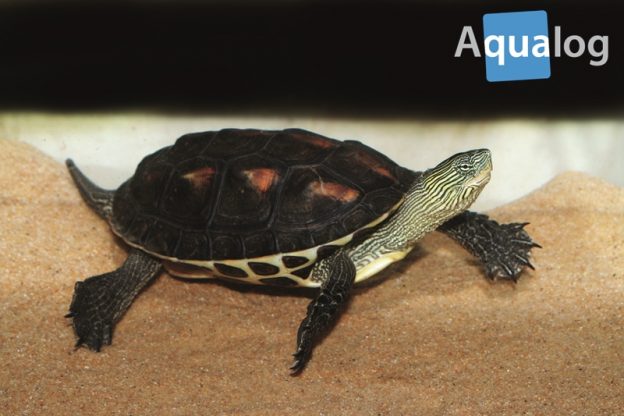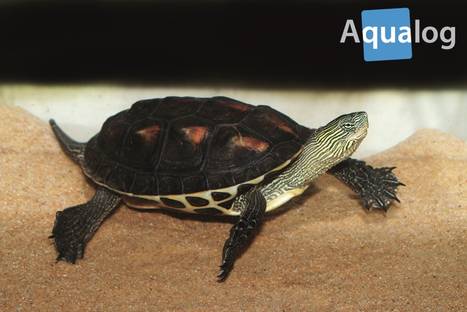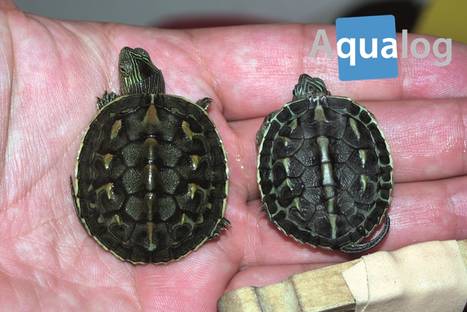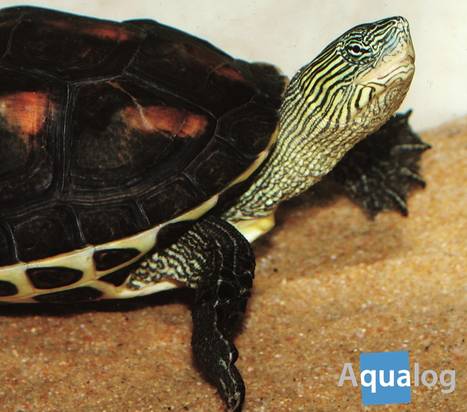
The outlook isn’t good for the wild turtle populations of East and South-East Asia. In China these animals are regarded as a delicacy and hence there are anachronistic depredations on their populations. As a result of this only a few species are available for the terrarium hobby, although the pet trade has no appreciable effect on wild populations.

One of the few exceptions is the Chinese Striped-Neck Turtle, Ocadia sinensis. It is bred in large numbers on farms and some of the hatchlings end up in the pet trade.
Pros and cons of captive-bred specimens
Whether you prefer to keep wild-caught or captive-bred specimens is fundamentally a philosophical decision. The frequently cited argument that captive-bred specimens are easier to keep, because they are already accustomed to conditions in captivity, is nonsense. A turtle is a wild animal and has no insights into its circumstances. The transfer of a turtle from one terrarium to the next is, from the subjective viewpoint of the turtle, no different to the transfer from the wild to a terrarium. It is true that the parents of captive-bred specimens apparently do verywell under the conditions provided by the breeder and proceed to breed. Hence the requirements for the arrangement of the terrarium and the climate for this special strain are known, which makes maintenance considerably easier if these data are passed on precisely. On the other hand, wild specimens, once settled in, are usually more robust and less susceptible to disease, especially when they are somewhat older, as we mustn’t forget that in the wild 70-90% of youngsters die before reaching sexual maturity (disease, starvation, negativeenvironmental influences, predators). Those that survive this selection are already very robust. Fundamentally, wild-caught specimens are more suitable for experienced terrarium keepers than for beginners, as the unavoidable negative stress resulting from capture, transportation, change of diet, etc will weaken the animal and hence disease may strike. Nowadays there is plenty of experience-based information available on how to tell how fit a turtle is by looking at it. But in the case of the Chinese Striped-Neck Turtle the question doesn’t arise at all, as only captive-bred specimens are available in the trade. The trade in Chinese Striped-Neck Turtles is subject to no legal regulations of any kind.

Youngsters require special care
This applies to turtles just as to any other animal. Accordingly maintenance must be optimal to ensure that the animals thrive. Those available in the trade are usually hatchlings with a carapace length of around 3-4 cm. They are best housed in a 50-60 cm long aquarium. The water depth should be around 10 cm, as otherwise the littlecreatures could easily drown. During the settling-in period at least, provision should be made in all four corners of the terrarium for the little turtles to climb out of the water. As a turtle that wants to leave the water will always swim to a corner of the aquarium.
Chinese Striped-Neck Turtles are swamp turtles. This means that they are excellent swimmers and divers that search for their food in the water and flee there to escape their enemies, but which always require a dry place on land where they can warm up and dry out; in addition adult females lay their eggs on land.
Probably the commonest mistake in the maintenance of swamp and aquatic turtles is to ignore or only inadequately apply the rules of the aquarium hobby. The water area of the turtle terrarium is an aquarium and an aquarium requires biological filtration, as otherwise toxic substances, especially nitrite, will accumulate in the water. Hence it is important that the newly-purchased turtles should be placed in a rearing aquarium with a mature filter. The ideal for rearing baby turtles is a Hamburg filter mat covering the rear wall of the tank. The slow-running filter is very effective, provides the little ones with a good way of climbing out, and there is no danger of the little turtles being sucked in and perhaps drowning because they are unable to escape again from the suction of the filter.
A number of small, agile fishes (Guppies, Cardinal Tetras, Zebra Danios) should always be placed in the aquarium. If the fishes are doing well then the water is also as it should be for the turtles. The same applies as for any aquarium: a maturation period of 3-6 weeks is required before any livestock is added!
Ocadiababies are particularly susceptible to fungus, which can very rapidly assume serious proportions. Once this disease has broken out the turtles will be almost impossible to save. Prevention is the method of choice here! A well-matured filter is half the battle, andCatappaleaves, alder cones, and dead oak, beech, birch, and alder leaves will ensure biologically functional water in which the turtles are unlikely to fall ill.
Temperature and light
This is where the majority of mistakes in maintenance are made. The water temperature should be between 16 and 26°C (optimum: 20-24 °C). But far more important than the prevailing water temperature is the need for the air temperature to always be 2- 3 °C higher than the water temperature. Otherwise respiratory diseases may occur. So the water area should never be heated when the terrarium is situated in the house! The higher air temperature will come about automatically, as the turtles require an area to sun themselves. This can be provided by having an “island” of cork floating on the water and secured beneath a heat lamp using a cord. The heat lamp should be positioned so that the temperature in the warmest spot, immediately beneath it, measures 35 °C. Bear in mind that because of their body height the turtles will be somewhat closer to the heat source! Henceas they grow the distance from island to lamp should be gradually increased.
Ocadia sinensisare diurnally active turtles, and hence the tank should be illuminated to simulate daylight for the occupants. As a rule of thumb it is advisable to use 0.5 watts of fluorescent lighting per liter of nett volume of the tank (not just the water part!), and the lighting should be on for around 12 hours per day. UV light will do no harm, but isn’t absolutely necessary for the rearing of healthy Chinese Striped-Neck Turtles. But essentially I would recommend it.

Food
Ocadia sinensisis an omnivore. A common mistake when feeding is to offer mainly carnivore foods. They should be fed 3-4 times per week with lettuce, dandelion, and aquatic plants, once per week with bloodworm (available in the pet trade in deep-frozen form for ornamental fishes), once per week with whole Stint (available deep frozen in the pet trade as feeder fish), and 2-3 times per week with proprietary food sticks for young aquatic turtles.
Maintained in this way, the turtles will attain their maximum size of 20-30 cm (depending on the population) in 4-6 years, with males essentially remaining smaller (15-25 cm). Adult specimens should be fed plant material, plus Stint, river shrimp (Gammarus), and sticks.
Behavior
Ocadiaare essentially fairly peaceful and females at least can readily be maintained in a group. Some sexually mature males can, however, be very troublesome because of their permanent readiness to mate and mustthen be kept singly or always only temporarily with the females. A tank measuring around 150 x 50 x 50 cm will suffice for a group of three adult specimens. Individual males can readily be housed in tanks of around 100 x 40 x 40 cm.
From May to September Chinese Striped-Neck Turtles can be readily maintained in (escape-proof!) tanks outdoors. Depending on the population, they can also be overwintered at low temperatures, but essentiallythis is advisable only with individuals at least two years old.
One of the few exceptions is the Chinese Striped-Neck Turtle, Ocadia sinensis. It is bred in large numbers on farms and some of the hatchlings end up in the pet trade. Pros and cons of captive-bred specimensWhether you prefer to keep wild-caught or captive-bred specimens is fundamentally a philosophical decision. The frequently cited argument that captive-bred specimens are easier to keep, because they are already accustomed to conditions in captivity, is nonsense. A turtle is a wild animal and has no insights into its circumstances. The transfer of a turtle from one terrarium to the next is, from the subjective viewpoint of the turtle, no different to the transfer from the wild to a terrarium. It is true that the parents of captive-bred specimens apparently do verywell under the conditions provided by the breeder and proceed to breed. Hence the requirements for the arrangement of the terrarium and the climate for this special strain are known, which makes maintenance considerably easier if these data are passed on precisely. On the other hand, wild specimens, once settled in, are usually more robust and less susceptible to disease, especially when they are somewhat older, as we mustn’t forget that in the wild 70-90% of youngsters die before reaching sexual maturity (disease, starvation, negativeenvironmental influences, predators). Those that survive this selection are already very robust. Fundamentally, wild-caught specimens are more suitable for experienced terrarium keepers than for beginners, as the unavoidable negative stress resulting from capture, transportation, change of diet, etc will weaken the animal and hence disease may strike. Nowadays there is plenty of experience-based information available on how to tell how fit a turtle is by looking at it. But in the case of the Chinese Striped-Neck Turtle the question doesn’t arise at all, as only captive-bred specimens are available in the trade. The trade in Chinese Striped-Neck Turtles is subject to no legal regulations of any kind.
Anzeige






